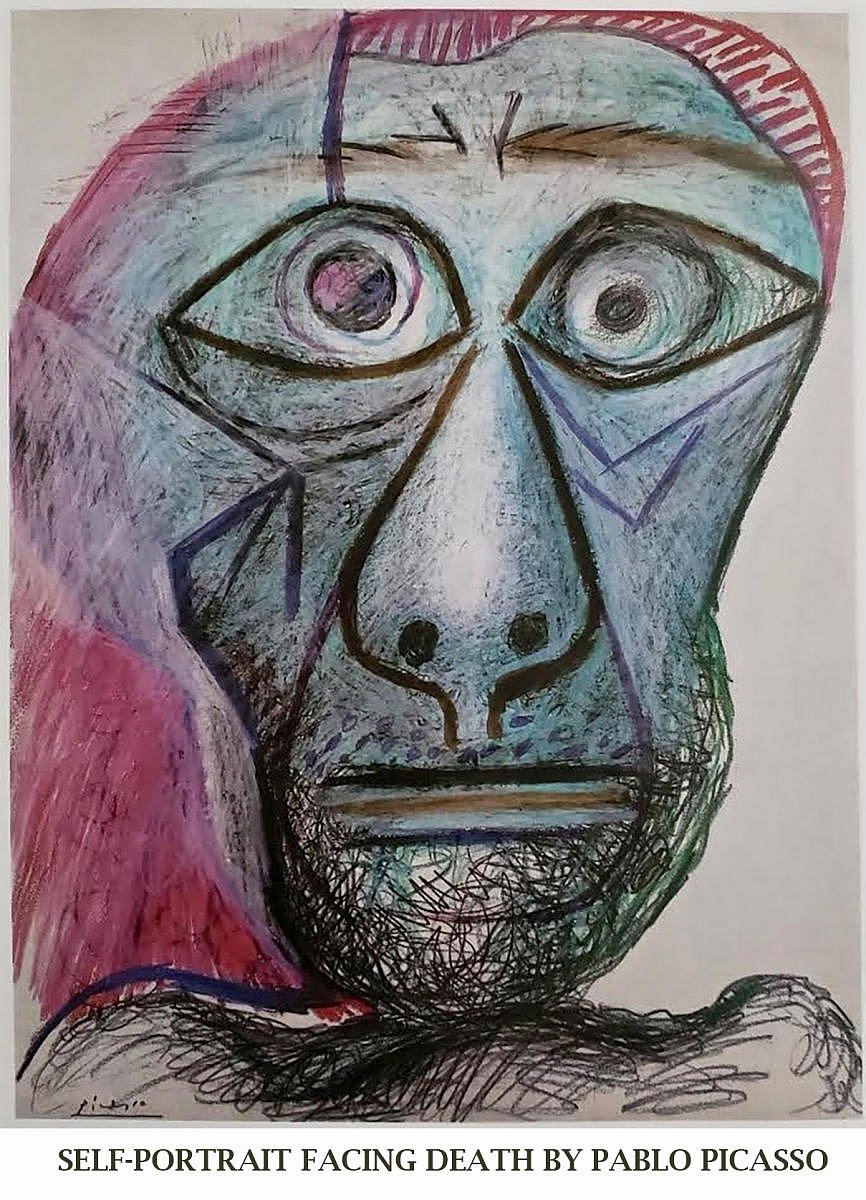
In the last four years of his life, Pablo Picasso is said to have created more paintings than at any other comparable period of his life. The Spaniard, according to historians, allowed himself unbridled freedom while demanding the coarsest articulation and position of his figures. “Death holds no fear for me. It has a kind of beauty,” he famously said.
Often applying pure colours straight from the bucket onto his canvas he produced an array of seemingly crude but commanding images. “Primitive but matchless, these paintings are superior to their expressive descendants of today,” wrote a critic years later. “Resembling members of a burlesque troupe, they demand everyone’s attention.”
In 1968, when he was 87, Picasso made an expansive series of paintings with an astonishing range of erotic and other themes. Four years later, he painted ‘Self-Portrait facing Death’ using pencil and crayon on paper. It is clearly a portrait of fear. The image shows him as a scrawny old man, with bulging eyes, a greenish skull, and a chest covered with scribbles of hair. Arguably the most famous work produced in his late career, the 65x50cm image had taken several months to complete.
Looking in the mirror
Picasso’s friend and biographer Pierre Georges Daix (1922-2014) recalled his visit to the artist’s studio. “[Picasso] held the drawing beside his face to show that the expression of fear was a contrivance.” Three months later, when Daix visited him again, the harsh coloured lines on the painting seemed to have gone deeper. Picasso told Daix: “I think I have touched on something. It is not like anything ever done.” Daix recalled later: “He did not blink. I had the sudden impression that he was staring his own death in the face, like a good Spaniard.”
With its deep disturbing lines and petrified look ‘Self-Portrait facing Death’ has intrigued critics for decades. The story goes that it was on June 30, 1972, that Picasso had looked at himself in a mirror; and seen in that mirror an image of an old man rapidly moving to the end of his life. Nine months later, on April 8, 1973, the most famous artist of the 20th century was gone. Picasso’s death was sudden. In the early hours of the fateful Sunday, he was unable to get out of bed. He called out for his wife, before suffering a fatal seizure. The 91-year-old artist who had produced thousands of artworks had been working till just hours before his death.
The art world reacted to the news with shock and grief. “Picasso’s art more than any other has given our century confidence in the creative powers of man,” wrote Meyer Schapiro, art historian. Hailing Picasso as a major force in the 20th century, Carter Brown, director of the National Gallery of Art said: “He is one of its authentic geniuses in any field. He has changed the way we see.”
Dear departed
Picasso painted death or death-related themes all his life. In fact, it was the suicide of his friend and artist Carles Casagemas (1880-1901) that triggered his dark, tragic and melancholic paintings during the so-called Blue Period.
Casagemas was one of Picasso’s closest friends in his youth. In 1900, the two artists, almost the same age, shared a studio in Barcelona. They even frequented brothels in Barcelona where Casagemas became aware of his sexual impotence. The two artists made their first trip to Paris together in the same year and shared another studio. While in Paris, Casagemas struck a friendship with the model Laure Gargallo Germaine and fell passionately in love with her. In February 1901, when she spurned his proposal to marry, he fired a bullet (unsuccessfully) at her before shooting himself in the head at a nightclub in Paris. (She survived).
The death of his dear friend haunted Picasso and left him shaken. It resulted in three paintings that imagined the funeral scene. These works were not shown in public until the 1960s. Critics believe that in many ways the death of Casagemas gave a new direction to Picasso’s artistic journey. Two years after Casagemas’ death, Picasso painted a large canvas (6.45 ft×4.24 ft) titled La Vie (The Life). Widely regarded as a masterpiece of Picasso’s Blue Period, the painting shows Casagemas standing as a central figure.
In the winter of 1907-08, Picasso was to lose another close friend, the German painter Karl-Heinz Wiegels. Picasso smoked opium several times a week between 1904-08. He supposedly indulged in opium nights in his studio with several other artists. These opium nights ended abruptly after the suicide of Wiegels, who suffered a psychotic breakdown after indulging in a cocktail of opium, hashish, and ether. Picasso found Wiegels hanging from a ceiling beam. Such was the shock of Wiegels’ death that Picasso never smoked a single pipe of opium again. As a homage to the German artist, Picasso painted a haunting image titled Still life with Skull.
More than three decades later, Picasso was to paint another Still life with Skull to commemorate the death of Spanish sculptor Julio Gonzalez (1876-1942).
González, who had developed the expressive use of iron as a medium for modern sculpture, and Picasso were good friends.
Their friendship and collaboration were mutually beneficial and helped both in exploring new directions in their art. While Picasso received technical assistance from González in executing iron sculptures, González’s works often showed Picasso’s cubist influence. González supposedly was the only artist with whom Picasso shared his personal art notebook.
Throughout his artistic life, Picasso confronted death in his work. And when the time came, he did not resist depicting his own mortality by painting ‘Self-Portrait facing
Death’.